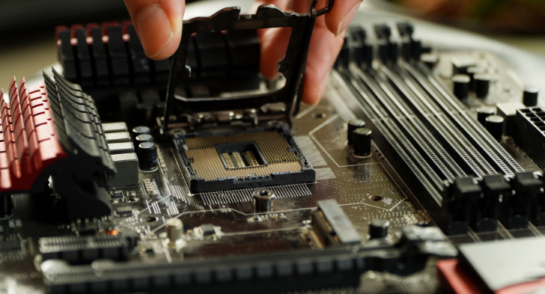For more than a year unforeseen events have been impacting supply chains beyond recognition. It has not only been about COVID-19 itself but also underlying fluctuations in demand and supply. Shipping container shortages, freak weather events, fires in silicon fabrication plants, electric vehicle demand, and port bottlenecks have all played a role in ‘a perfect storm’ which has led to further complication. We may now be starting to emerge from the immediate crisis, but the lasting impact remains.
But it is the global shortage of semi-conductor chips that may have the most far-reaching impact. Chips are in everything from computers, phones, vehicles and medical equipment to washing machines, manufacturing equipment and network devices. The shortages have wreaked havoc on all of them causing real consequences for organizations. The consensus is that it will take around two years to normalize.
Semi-conductor chips
Many wild theories still abound. Global supply chains were fragile, it was difficult to import goods from Pacific Rim countries and that disruption was due to geopolitical risks. The reality is a bit simpler.
A major chipmaker TSMC, based in Taiwan, slowed its output when auto and other manufacturers cancelled their chip orders in the first half of 2020. The shortage was immediately apparent when an unexpected rebound in the market for cars and consumer electronics happened, starting in the last quarter of 2020.
Wenzhe Zhao, director of global economies and strategy at Credit Suisse, said recently that the recent chip shortages have encouraged inventory hoarding along chip production chains, widening the gap between expanding demand and stagnant supply. Major US producers are now rethinking their inventory policies. We are expecting them to increase buffer stocks of vital components to ensure this problem does not recur. The question is: who bears the cost and how can we avoid this from recurring?
It’s not only about chips. Shortages and long lead times are affecting the production of goods that require prime grade plastic components. Since March 2020, events have been putting severe strains on supplies of plastic raw materials, base plastics and compounded plastics.
Help is on the horizon
While we are in a recovery period, we can see there are definite moves to mitigate the risk of future shortages. Intel announced a $20 billion plan in March to expand its advanced chip manufacturing capacity, building two factories in Arizona and opening its plants to outside customers. This will have a positive effect on the US economy and will challenge the industry leaders, TSMC and Samsung. Both companies have also committed to boosting their manufacturing capacity. Currently, two-thirds of the world’s advanced chips are made in Asia.
Limiting risk and protecting revenue
Companies are navigating a major impact on their bottom line due to the shortage of components. Many have been unable to fulfil their obligations within their service level agreements (SLAs) with their customers, sometimes incurring penalties. All this impacts the end consumer. However, some positive steps can be taken to mitigate future problems:
1. Understand your supplier’s suppliers
Many supply chain professionals were caught off-guard during 2020 because they did not have full visibility into their sources of supply. An electronic product includes many elements; it is important to know where they come from. Knowing your Tier One suppliers is not enough. Pay attention to Tier Two and Tier Three suppliers that are critical to your business. Supply chain failures can happen at any level.
2. Expand your supplier base
Investigate alternative supplier sources even though they may be time-consuming and require some investment. Develop strategic partnerships with new distributors, resellers and traders that can source urgent components. It will pay off in the long term by reducing market risk.
3. Track market indicators
Gather market intelligence on pricing trends and supply constraints. Sales projections are early indicators of global requirements. Early warning of disruptions in a volatile environment can prompt quick action for competitive advantage.
4. Think outside of the box
It may be worth considering very different sources for component supply. For example some organizations are now investing significantly in recovering certain high-value items – including semiconductor chips – from previously used parts as part f a service event. Recovering such items and circling them back into the manufacturing supply chain can increase the overall resilience of the chain as you are now less reliant on 3rd party suppliers, and it helps with sustainability targets too!
Navigating the challenges
The last point in particular is becoming an important initiative for a number of manufacturing companies and assemblers as they search for innovative solutions to the unavailability of new components. Accessing the secondary market where pre-owned or refurbished assets are recovered and repurposed as a solution to the shortages means that prices are less dictated by high demand, stock is easily available, and delivery is quick. Equipment life cycles can also be further extended so there are environmental benefits too. The digitization of the asset recovery process using analytics is becoming a critical success factor in business continuity. Cloud-based platform-as-a-service (PaaS) solutions can help your company mitigate the impact of parts shortages and fulfil the needs of customers. No customer wants to hear that dreaded “out of stock” message.
To hear more on this topic, OnProcess is doing a live webinar with Service Council and iRhythm on July 21st at 11 am ET. To gain more insights on how to think ‘completely out of the box’ to deal with the global semi-conductor shortage and other unprecedented uncertainties, join us. You can register for free here
RELATED CONTENT


Infographic: Is anyone using AI and Machine Learning in the Service Supply Chain?




Sign up for updates
Get the latest updates on our new services and fresh content — straight to your inbox.
